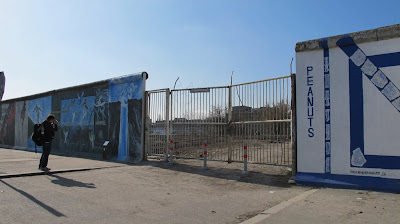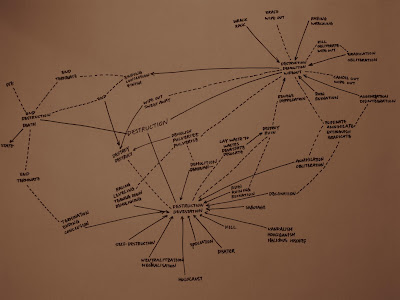Tuesday, 27 July 2010
Saturday, 26 June 2010
Friday, 18 June 2010
Gordon Matta-Clark
Gordon Matta-Clark was born in New York in 1943 and died in 1978. He studied French literature at the Sorbonne and Architecture at Cornell University. From the early 1970s, as a founding member of the artist-run Food Restaurant in New York's SoHo neighborhood, Matta-Clark participated in numerous group exhibitions and projects. His work was presented in Documenta V, Kassel, Germany; and at exhibitions in Sao Paolo, Berlin, Zurich, and in the 9th Biennale de Paris. Major projects by Matta-Clark were staged in Aachen, Paris and Antwerp.
Following his death, major retrospective exhibitions have been organized by the Museum of Contemporary Art, Chicago; Badischer Kunstverein, Karlsruhe, Germany; and IVAM Centro Julio Gonzalez, Valencia, Spain, among others. In 2007, the Whitney Museum of American Art, New York, honored him with a retrospective entitled "Gordon Matta-Clark: You Are the Measure."
Each 356 x 508 mm
Each 356 x 508 mm

This is one of the Notable Entries for the Reburbia: a Suburban Design Competition going on now over at re-burbia.com.
I personally think this entry titled, Glass Houses: (Matta) Clark County, Nevada is brilliant. I’ve always loved the work of Gordon Matta-Clark which this entry uses beautifully as inspirational precedent.
“Nevada has the highest foreclosure rate in the United States. 70,000 homes are affected- meaning 1 in 16 in homes is vacant. Not coincidentally, there are nearly 6,000 Clark County School District students who are now considered homeless. 1/3 of the homeless in Nevada are children under the age of 18, suggesting a much larger floating homeless population.
Re-inventing suburbia today is not a matter of making better houses or improving suburban planning. This project, although highly speculative, seeks to suggest a means of closing the gap between a near-absurd excess of new but vacant suburban homes across the nation, and our tragic, burgeoning homeless population.
We proceed from a Gordon Matta-Clark like vivisection of the typical subdivision. Each house within a standardized block is subdivided into four unequal units separated by a 3 meter wide gap that provides communal access and light. The interiors of each unit are reconfigured and capped with double glazed plates. The glass offers both a means of delivering acoustical and light control (via electrified privacy film.) Thermal control is delivered by employing the cavity space as a temperature buffer.
The ambition of re-envisioning the suburb must address what to do with the human as well as physical fall-out created by failed suburban development models and toxic financial speculation. Until we address the literal and metaphorical implications of these issues we are just gilding the suburban lily.”
For more on the other amazingly innovative entries check them out on theReburbia website. Voting going on now for the winners out of the top 20 selected finalists.
Thursday, 17 June 2010
Cornelia Parker

b. 1956, Cheshire, England
For some years Cornelia Parker’s work has been concerned with formalising things beyond our control, containing the volatile and making it into something that is quiet and contemplative like the ‘eye of the storm’. She is fascinated with processes in the world that mimic cartoon ‘deaths’ – steamrollering, shooting full of holes, falling from cliffs and explosions. Through a combination of visual and verbal allusions her work triggers cultural metaphors and personal associations, which allow the viewer to witness the transformation of the most ordinary objects into something compelling and extraordinary. Lately Parker’s attention has turned to issues of globalisation, consumerism and the mass-media.

- Cold Dark Matter: An Exploded View, 1991
- A garden shed and contents blown up
- Dimensions variable
- Breathless, 2001
- Brass musical instruments, flattened
- Alter Ego, 2004
- Silver plated objects, wire
- Quoting artist Cornelia Parker as she discusses her work, including Cold, Dark Matter: An Exploded View from 1991:
“I resurrect things that have been killed off... My work is all about the potential of materials - even when it looks like they've lost all possibilities.”
“It's a modern condition: the threat of bomb scares, and the fear it symbolizes. From seeing explosions on the news and all the time in films you sort of think you know what they are, but really your firsthand knowledge of it is very limited. I realized I'd never walked through the detritus of a bombed-out building."
"I like the life/death resurrection bit, which is very Catholic, something dies, but it's resurrected in another form."
Monday, 26 April 2010
Queen & David Bowie: Under Pressure
Um bum ba de
Um bu bu bum da de
Pressure pushing down on me
Pressing down on you no man ask for
Under pressure - that burns a building down
Splits a family in two
Puts people on streets
Um ba ba be
Um ba ba be
De day da
Ee day da - that's o.k.
It's the terror of knowing
What this world is about
Watching some good friends
Screaming 'Let me out'
Pray tomorrow - gets me higher
Pressure on people - people on streets
Day day de mm hm
Da da da ba ba
O.k.
Chippin' around - kick my brains around the floor
These are the days it never rains but it pours
Ee do ba be
Ee da ba ba ba
Um bo bo
Be lap
People on streets - ee da de da de
People on streets - ee da de da de da de da
It's the terror of knowing
What this world is about
Watching some good friends
Screaming 'Let me out'
Pray tomorrow - gets me higher high high
Pressure on people - people on streets
Turned away from it all like a blind man
Sat on a fence but it don't work
Keep coming up with love
but it's so slashed and torn
Why - why - why ?
Love love love love love
Insanity laughs under pressure we're cracking
Can't we give ourselves one more chance
Why can't we give love that one more chance
Why can't we give love give love give love give love
give love give love give love give love give love
'Cause love's such an old fashioned word
And love dares you to care for
The people on the edge of the night
And love dares you to change our way of
Caring about ourselves
This is our last dance
This is our last dance
This is ourselves
Under pressure
Under pressure
Pressure
Wednesday, 21 April 2010
Berlin Wall
Will it Blend?
Tuesday, 20 April 2010
Sunday, 18 April 2010
Saturday, 17 April 2010
The Disappearance of Architecture as an Artistic Theme–Part 2
Friday, 16 April 2010
The Disappearance of Architecture as an Artistic Theme–Part 1
Thursday, 15 April 2010
The Belly of an Architect (1987)
Tirelessly dedicated to the project, Kracklite's marriage quickly dissolves along with his health. His physical and social ruin in some way corresponds to the decline of his idol Boullée, who remained relatively forgotten until the twentieth century.
Kracklite becomes obsessed with the historical Caesar Augustus after hearing that Livia, the wife of Augustus, supposedly poisoned him. Kracklite assumes that his own wife Louisa has tried to do the same due to his increasing stomach pains.
plot summary from wiki
I read some comments about the film, it seems people are much full in love with the music rather than film itself. The music is written by Wim Mertens, an Belgian musican. Here is a videoclip from him.






































